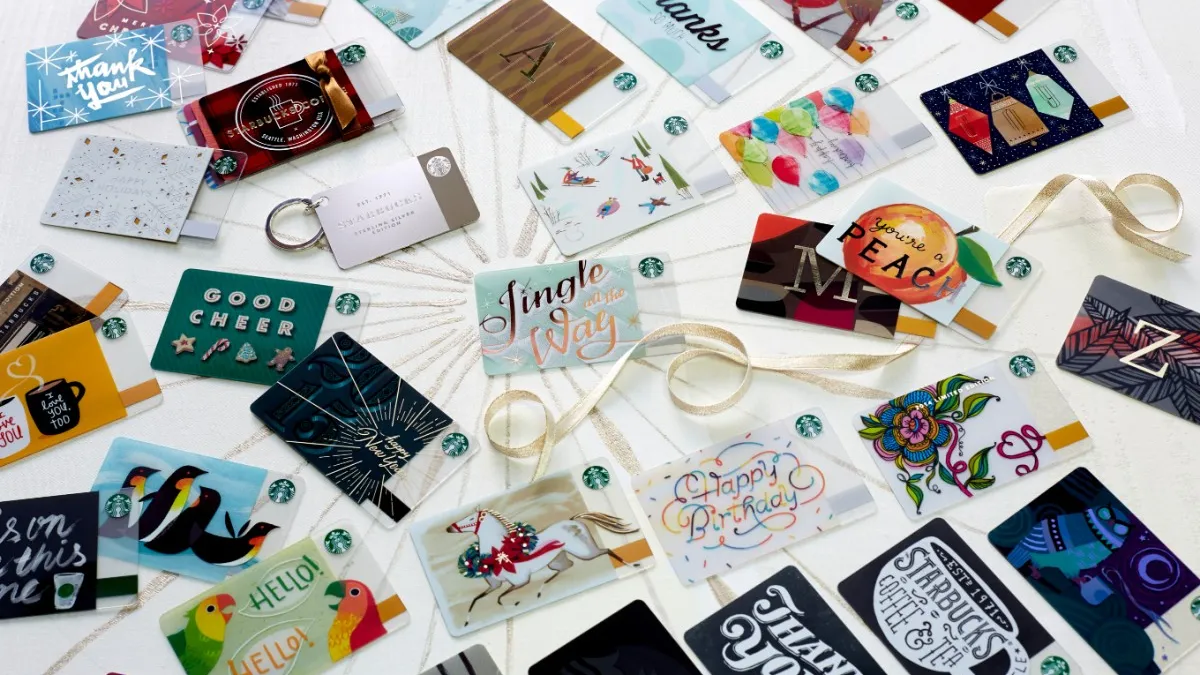This holiday season, consumers will purchase four gift cards on average for family members. As the second most popular gift purchased for the holidays, after clothing and accessories, gift cards account for 55% of all gift spending, according to the National Retail Federation. American retailers and restaurants will receive an estimated $29.5 billion in gift card sales this holiday season.
"Around 40-50% of gift card purchases are done in the November/December time frame," Erin Wood, spokeswoman for the Retail Gift Card Association, told Supply Chain Dive. "Gift cards are generally redeemed within the first few months of receiving them."
That’s a lot of goods and services to be fulfilled after the holiday season ends, during the slower January months and beyond. The popularity of gift cards is affecting retail operations in unexpected ways.
The impact on inventory, pricing decisions
Retail sales typically slow down in January, and gift cards can bring much-welcomed traffic to deplete that holiday inventory, said Wood. Redemption rates sometimes vary depending on the retailer type. For subscription services, more than 90% are redeemed within a month, with 65% redeeming them within seven days, according to a Recurly survey.
Even with an increase in gift card sales year over year, retailers will likely not carry more or different inventory for gift card consumer shopping, said Moutaz Khouja, PhD, a professor of operations management at the University of North Carolina.
The bigger question is pricing. "If I’m a retailer and I know there’s a lot of gift cards (outstanding), maybe I shouldn’t have a lot of sales," Khouja told Supply Chain Dive. Consumers with gift cards don’t look at them the same way as money and may be willing to spend more on an item using a gift card than they would with their credit card. However, if gift cards represent only a small percentage of a retailer’s overall sales, the pricing and inventory response may be negligible, he said.
"Retailers do want to carry a good assortment, as they want customer satisfaction and good will," even for the gift card holders, he said.
If a gift card features a particular product on the design, the retailer should stock up on that product after the cards are distributed. That could be a specific food item, for example, as the power of suggestion will bring more consumers in to purchase it.
4 reasons retailers like gift cards
- Consumers pay an average of $59 more than the gift card’s value when purchasing with a gift card, according to First Data’s 2018 Prepaid Consumer Insight study.
- There are fewer returns. "Returns are a huge headache for retailers," Khouja said. He estimates that annual returns are more than $1 billion a year, with an average of 7% of products returned. A lot of the returns happen during the holidays and then have to be discounted for resale. "If you give someone a gift card, they’ll get something they like," Khouja said, resulting in fewer returns.
- Some cards aren’t redeemed in whole or in part, improving a retailer’s profits. In 2017, about 19% of gift card value remained in the marketplace nine months after issue, said Khouja. "People forget, they misplace the card," or they may just spend part of it.
- Consumers must use the gift card at the issuing store, if it’s a "closed loop" card, not refillable and used at stores owned by one company. An example would be a Target gift card, only redeemable at Target, or a Gap gift card, that can also be used at Athleta, Baby Gap and Banana Republic. A Visa gift card, on the other hand, is an open loop card and can be redeemed anywhere like cash.
Omnichannel reaches gift cards
While the holiday season may account for the largest percentage of gift card purchasing, companies and individual consumers buy them year-round.
Retailers use them to spur sales, as employee rewards and for occasions like birthdays, non-December holidays and other celebrations like the Moms/Dads/Grads timeframe. Some brands spike around back-to-school season, with people buying gift cards to send with students to school, said Wood.
Gift cards in the U.S. brought in an estimated $314.35 billion in 2017, and the market is estimated to increase to $750 billion by 2026 internationally, using a 10.1% compounded annual growth rate, according to Credence Research. Slightly more than half of the gift card value is from closed loop gift cards.
"If I'm a retailer and I know there's a lot of gift cards (outstanding), maybe I shouldn't have a lot of sales."

Moutaz Khouja
Professor of Operations Management, University of North Carolina
The reason for this growing popularity? The technology needed to offer and process them is readily available, said Khouja. Just like consumers appreciate omnichannel purchasing options, they want omnichannel gift card options as well. Digital gift cards are popular for giving and receiving, especially for those in the 18-24 age range. More than half of customers surveyed by Gift Card Granny want to store the gift cards on their phones, a percentage increasing to 74% for those 18-24.
Digital use may help decrease the number of lost cards and "breakage," the amount of outstanding card value. Breakage is typically 2-4% of gift card sales, though it depends on the retailer and industry, as well as on whether there are enough funds left over to complete a purchase. The U.S. government passed laws in 2009 prohibiting gift cards from expiring within five years of activation and limiting inactivity fees as well.
Khouja said the expiration date doesn’t impact the actual redemption rates. "You think you have more time. You forget about it. If it expires in two years versus not expiring, it doesn’t make a big difference," he said.






















